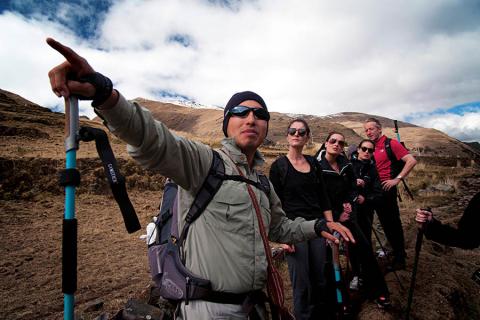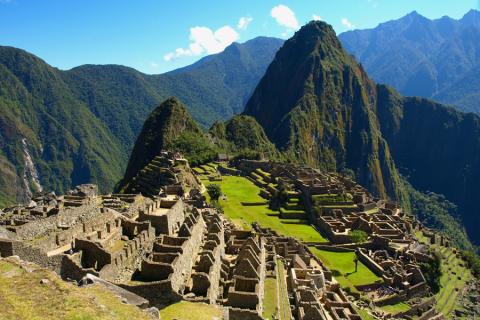
The Lares trek: an alternative Machu Picchu hike
If you’re thinking of visiting Peru, a visit to the ancient citadel of Machu Picchu will likely be high on your list of place to visit. And if, like me, you enjoy hiking – you have a few options to get there, including the classic Inca Trail, the Salkantay Trek, a trek via Choquequirao and finally, the Lares Trek.
Of the three, a less-trodden Machu Picchu hike is the Lares trek, which promises challenge and adventure whilst avoiding the crowds. The Lares trek is a 3-day trek, so it’s a day shorter than the Inca trail, but it reaches a higher altitude of 4,600m.
It makes a great alternative to the Inca Trail since you currently don’t need a permit for this hike (unlike the very well-known Inca Trail), so you don’t need to plan your trip quite so far in advance.
Taking the Lares route means you’re likely to see for more local people than other hikers as you pass through remote mountain communities. You’ll have an excellent opportunity to learn about the fascinating Inca history and culture and see rural Andean life up close.

When to go
The best time to trek the Lares route is the drier period from May to October, but the trek is open year-round. At this time of year, you’ll be able to enjoy clear skies and fabulous views.
I undertook this trek in March and whilst the weather was fairly wet at times, we still had a great time and we could appreciate the clear views when they came along! The weather also helped create a great bond and camaraderie between our group as we encouraged each other through the occasional storms and it increased the sense of achievement after battling against the elements – although this isn’t for everyone!
Acclimatisation
Before you start any of the Machu Picchu hikes, you’re advised to spend a few days before the trek in nearby Cusco to help your body acclimatise to the altitude. Machu Picchu may be the main draw here, but sights like Tambomachay, Q’enco and Saqsaywaman would be the highlight if they were situated anywhere else - so make sure you spend time exploring. I also recommend you get out into the Sacred Valley whilst you’re staying in Cusco as there are some amazing Incan ruins here too.

When it comes to trekking, a useful tip is to ‘trek high’ and ‘sleep low’ as it helps your body acclimatise more easily – and this is how the small group treks tend to operate.
The Lares route itinerary
Your first day will begin with the 3-hour drive from Cusco to the town of Lares, where the hike starts through the valley of Cuncani. The first leisurely 9km hike passes through the village of Chancachaca where you will stop for lunch.
After lunch, you’ll continue trekking to Cuncani at 3,872m where you will rest for the night. If you’re part of a group tour you’ll have the benefit of several porters and cooks, who somehow manage to cook up some of the most incredible food in the middle of nowhere! There’s plenty of time to relax as your tents will already set up when you arrive.

The second day will be the longest and toughest, covering 17km as you trek from the foothills of Sicilaccasa Mountain to the highest pass at 4,750m.
We were greeted with a beautiful clear sky as we set off early from camp. The 12km climb is at a slow, steady pace with plenty of rest stops to help you get used to the thinning air at this altitude. We found that it helps the adjustment if you just take your time and enjoy the surroundings and views. You can celebrate reaching the highest mountain pass by making an offering of coca leaves to the Andean gods, and it’s at this point you’ll get spectacular views over lagoons and snow-capped mountains – a real reward for your effort so far!
From here, the trek heads downhill for lunch at the village of QuencaPata before descending to lower altitudes and spending the night camping by a stream at an altitude of 4,100m.
The final day of the Lares trek takes 3-4 hours and involves a shorter 11km trek. Today you’ll pass lots of classic Andean flora and fauna including the famous llamas and alpacas in the valley of Pumajuanca. You’ll also see many friendly Quechan people dressed in beautiful traditional clothes, and your guide will be able to tell you plenty of stories about the local culture.

On this final day, our group visited one of the local dwellings to see how they live – a fascinating insight into life in the Andes. Their homes are simple and there is a real community spirit and with people helping each other and pitching in to share things. You’ll find people here show huge for ‘Pachamama’ (Mother Earth) and many Inca traditions remain today.
You may be surprised to hear the squeaks of guinea pigs (Cuy), which are kept warm under the bed. When they are bigger, guinea pigs are considered a real delicacy – and if you’re not too squeamish, you can give them a try in some of the restaurants or markets back in Cusco. In my opinion, they’re not the tastiest meat you will try (a bit tough!) but try if you dare!
The trekking part of your tour finishes in Pumahuanca where a private van and train will take you to back to Aguas Calientes where you can retreat to the comfort of your hotel and enjoy a well-earned beer!
So you’ve reached Aguas Calientes, the jumping-off point for Machu Picchu. Finally, you can either get the bus up to Machu Picchu in the morning or if you can deal with the early start, you could walk up at 4am to catch the sunrise. It’s a steep 90-minute climb under the stars, but it also gives you some time in the ruins before the hordes of tourists arrive, which I highly recommend.
Machu Picchu
Machu Picchu is simply remarkable and highly deserving of its rank amongst the 7 new wonders of the world. Since Machu Picchu is set on such a remote mountaintop location, the ruins are in excellent condition and the guided tour around the city is fascinating and very informative.

One more climb: Huayna Picchu
After exploring Machu Picchu, I’d highly recommend climbing the steep Huayna Picchu mountain for views over Machu Picchu, as we did. It’s one of the best places to see the city from above and get a magnificent perspective on how it was built in the shape of a condor. Again, the views are absolutely wonderful and you’ll have a panorama over the surrounding mountains. Majestic.
Another option: Choquequirao to Machu Picchu
The ultimate adventure and truly off the beaten track. Choquequirao is comparable only to Machu Picchu in its grandeur and architectural accomplishment. It is built at the top of an almost untouched mountain and ‘discovered’ in the last 3 decades.

There are no roads here, so the only way to reach Choquequirao is on foot. From here you trek through the Salkantay pass and approach Machu Picchu from the rear. As with the Lares route and Salkantay trek, you reach Aguas Calientes the night before Machu Picchu.
Overall it is an 8-day trek and is the option I would take if I were to return. All the guides we spoke to said they loved Choquequirao especially as it was so much quieter in terms of tourist visits.
Interested in the Lares route or another Machu Picchu hike?
If you’re interested in visiting Peru or you’d like help choosing which Machu Picchu hike is best for you, I can help. From my own experience, I can advise and plan your trip, including flights, treks and accommodation – simply contact Chris to start planning a trip.
You might also like

Inca Trail alternatives: the Salkantay trek to Machu Picchu

Chris West
Senior Travel Consultant
at Travel Nation

About the author Chris West
Senior Travel Consultant
With his studies in Geography and Master’s degree in development behind him, Chris set off to leave pretty much no mountain unclimbed. His passion for adventure has driven him to climb both Kilimanjaro and Annapurna Base Camp in Nepal and he and his wife have also traversed Canada and all the way down through the Americas by bike! Even starting a family didn’t really slow down Team West, as they took their little daughter on a campervan road trip through the US National Parks. Chris joined Travel Nation as a round the world specialist in 2011 and is also one of our Business Class consultants. He really enjoys helping other families put together trips they’ll never forget.

Last trip:
Indonesia













